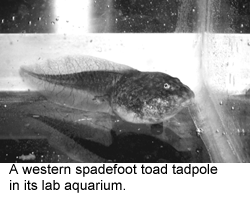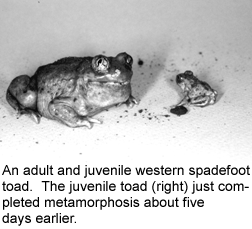The University Record, May 6, 1997
Hormone of stressed-out tadpoles may
hold secret to inducing birth
By Sally Pobojewski
News and Information Services
 Feeling trapped in a dead-end job? Stressed-out by a demanding boss? Harassed by whiny toddlers? Then consider the escape mechanism of the lowly tadpole. Sensing drought or a shrinking food supply in its home pond, the tadpole produces a hormone that accelerates its transformation into a toad or frog—allowing it to grow legs and walk away from a stressful environment.
Feeling trapped in a dead-end job? Stressed-out by a demanding boss? Harassed by whiny toddlers? Then consider the escape mechanism of the lowly tadpole. Sensing drought or a shrinking food supply in its home pond, the tadpole produces a hormone that accelerates its transformation into a toad or frog—allowing it to grow legs and walk away from a stressful environment.
In an article published in the current issue of Hormones and Behavior, biologist Robert J. Denver identifies this stress hormone, called corticotropin-releasing hormone or CRH.
Found in all vertebrates from fish to mammals, increased levels of CRH have been shown to induce early birth in pregnant sheep and possibly humans as well. “CRH appears to be the primary neuroregulatory hormone produced by all vertebrates under stress,” says Denver, an assistant professor of biology and assistant research scientist in the Reproductive Sciences Program.
“CRH gives a larvae or fetus the ability to adapt to a changing environment by controlling the timing of its own development,” Denver said.
 The metamorphosis from tadpole to toad is a complex process directed by the brain and involving interacting hormones from the pituitary, thyroid and adrenal glands. In his experiments, Denver discovered that CRH increased production of two key hormones in this process—thyroid stimulating hormone (TSH) and adreno-corticotropin hormone (ACTH).
The metamorphosis from tadpole to toad is a complex process directed by the brain and involving interacting hormones from the pituitary, thyroid and adrenal glands. In his experiments, Denver discovered that CRH increased production of two key hormones in this process—thyroid stimulating hormone (TSH) and adreno-corticotropin hormone (ACTH).
Because CRH is present in and may regulate development of all vertebrates, it must have originated millions of years ago when vertebrate animal life first appeared in Earth’s ancient oceans, according to Denver.
Denver used western spadefoot toads in his laboratory experiments. These desert amphibians breed in rain-filled ponds that can dry up within days. To survive in such an unpredictable environment, adult toads have developed the ability to breed almost immediately after it rains. Tadpoles of some spadefoot toad species can complete their metamorphosis just eight days after they hatch.
When Denver gradually lowered the water level in the tadpoles’ lab aquariums, the tadpoles responded with increased production of CRH-like peptides 22 days after hatching and developmental changes which accelerated 25-26 days after hatching.
While the developmental process is more complex in mammals than in amphibians, CRH appears to be just as important in regulating the transition from the womb’s aquatic environment to terrestrial life at birth.
“If the developing fetus senses a deteriorating environment, producing CRH may be its way of accelerating the developmental changes it needs to survive outside the womb and how it signals the mother that it’s time to be born,” Denver said.
Denver’s research is funded by the National Science Foundation and the Office of the Vice President for Research. Undergraduates Marnie Phillips and Lew is Krain assisted with the research project.

